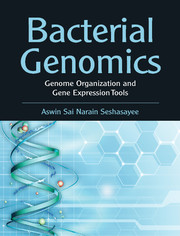Book contents
- Frontmatter
- Dedication
- Contents
- List of Figures
- Acknowledgements
- 1 Introduction: Bacterial Genomes and Gene Expression
- 2 Comparative Genomics in the Era of Sanger Sequencing
- 3 Studying Bacterial Genome Variation with Microarrays
- 4 Studying Bacterial Genomes using Next-Generation Sequencing
- 5 Genome-Scale Analysis of Gene Expression and its Regulation in Bacteria
- 6 DNA Methylation in Bacteria: A Case for Bacterial Epigenetics
- Index
4 - Studying Bacterial Genomes using Next-Generation Sequencing
Published online by Cambridge University Press: 05 April 2015
- Frontmatter
- Dedication
- Contents
- List of Figures
- Acknowledgements
- 1 Introduction: Bacterial Genomes and Gene Expression
- 2 Comparative Genomics in the Era of Sanger Sequencing
- 3 Studying Bacterial Genome Variation with Microarrays
- 4 Studying Bacterial Genomes using Next-Generation Sequencing
- 5 Genome-Scale Analysis of Gene Expression and its Regulation in Bacteria
- 6 DNA Methylation in Bacteria: A Case for Bacterial Epigenetics
- Index
Summary
Introduction
In the previous chapter, we had emphasised the enormous interest in studying fine-scale genetic variation even among closely related bacteria. Given the cost and time involved in pursuing Sanger sequencing for a large number of genomes, microarrays came into vogue for determining variation in gene content among related organisms. However, microarrays suffered from the following limitations. All said and done, hybridisation signals from microarrays remain a poor proxy for direct sequence determination. The exact nature and the extent of sequence divergence can not be determined. Second, the information that could be obtained depended on whether there were reference sequences for designing probes. Sequences that were unique to the genome sequence under investigation could not be determined. Therefore, there was a definite need for nucleic acid sequencing methods that could bypass the time and cost constraints of automated Sanger sequencing. In response to this need, there has been an explosion of next-generation or deep sequencing technologies in the last eight years or so. These technologies produce large volumes of sequence data in a short period of time and at a small fraction of the cost of a ‘first-generation’ automated Sanger sequencing experiment. They enable not just a reading of a DNA sequence (discussed in this chapter), but also permit a range of semi-quantitative applications typically associated with DNA microarrays. Popular next-generation sequencing systems are Illumina (also called Solexa), SOLiD (Applied Biosystems), 454 (Roche), Heliscope (Helicos Biosciences) and SMRT (Pacific Biosciences). Several other technologies including nanopore sequencing are in various stages of development and commercialisation. Benchtop sequencers, which are becoming increasingly available, make these technologies afford able to individual laboratories as opposed to core facilities.
In this chapter, we will provide a very brief overview of some general concepts underlying various next-generation sequencing technologies. This will be followed by an overview of the concepts underlying various computational procedures applicable to the use of these technologies for genome sequencing and re-sequencing.
- Type
- Chapter
- Information
- Bacterial GenomicsGenome Organization and Gene Expression Tools, pp. 60 - 88Publisher: Cambridge University PressPrint publication year: 2015

